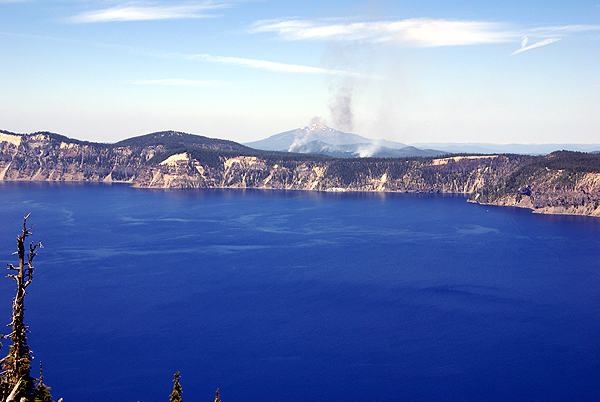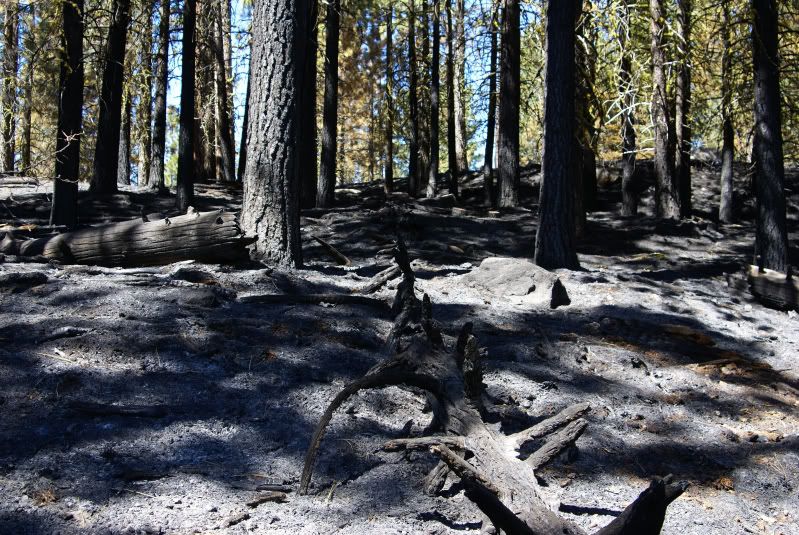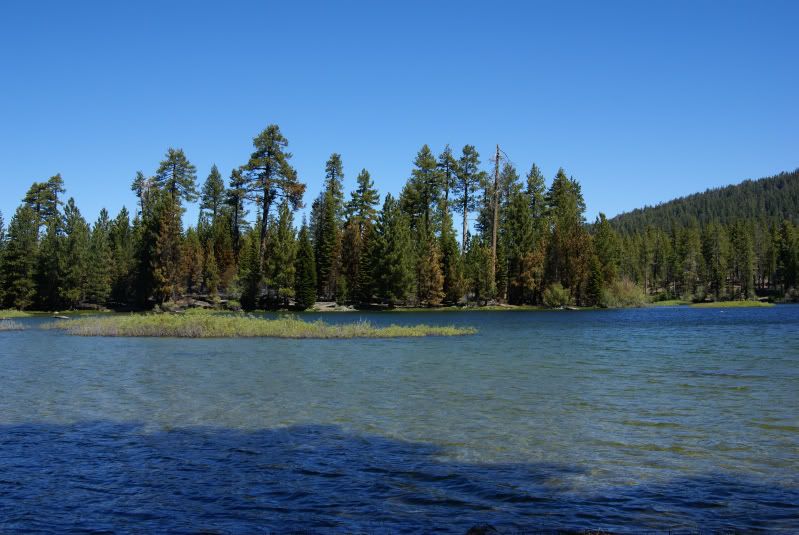I think I'm rather fortunate at this point in time to be back at school. Working in an air conditioned building right now is a good thing when the outside temperature is around 104˚. The heat always gets me thinking about fires since this is also our "fire" season.  This wouldn't necessarily be the case if we didn't have nutcases who get a thrill out of starting fires and if we'd had a better fire management system in place over the past 100 years or so.
This wouldn't necessarily be the case if we didn't have nutcases who get a thrill out of starting fires and if we'd had a better fire management system in place over the past 100 years or so.
When we visited Lassen last month and also when we visited Crater Lake last summer, there were prescribed burns happening in the parks. Over the course of the last hundred years or so, we've had a policy within our country of any fire being bad, and so therefore the fire was suppressed almost immediately. I can remember reading back in the early 1970s about forest fire management and how prescribed burns were now being applied to areas to get the forest back to where it should have been all along.
Clues that helped fire management personnel figure things out were burn scars on the bark of Giant Sequoias and other trees. This indicated that the big trees had survived many fires in the past. However, after many of the trees were protected within national and state parks fires were suppressed in order to protect these same trees. Park rangers were unaware at the time that they were doing more harm than good to the forests.
My family took my camping all over the western United States during the 60s and 70s. I grew up thinking that forests were deep and dark and very difficult to traverse except on trails due to the heavy underbrush and the think canopy of trees. Very little light penetrated to the forest floor, so very few plants grew. Many forest had uniform thick trees due to all of them sprouting around the same time.
Eventually, fire management teams realized that fire is a good thing for a forest. It clears out much of the over accumulation of pine needles and other forest duff that accumulates over the years.  It was discovered that many forest had small fires burn through them perhaps as much as every 10 years of so. Think about a forest that had over a century of forest pine needles accumulated waiting for a small spark that would start a conflagration.
It was discovered that many forest had small fires burn through them perhaps as much as every 10 years of so. Think about a forest that had over a century of forest pine needles accumulated waiting for a small spark that would start a conflagration.
This is what happened in September 1988 in Yellowstone National Park. Several small, lightning started fires were allowed to burn. Then, the fires got out of control and much of Yellowstone burned. The fires probably helped in the long run, but it was a catastrophe at the time. I had visited the park in 1987 and I remember watching the fires come ominously close to many of the places I had been barely a year previously. It was a very sobering sight to say the least.
In Southern California, we have an entirely different ecosystem, with many bushes and a lot less trees. When we get fires, they tend to get ugly very early. We haven't had a fire in the foothills behind our house in about 7 years. I've hidden a geocache puzzle up in those hills, which was originally entitled The Dead Forest? mainly because there was very little vegetation up there following those fires, yet the question mark at the end held out for the promise of new growth. The cache is now called Cobol Canyon Cache, because the forest is definitely not dead any longer. Whether prescribed burns would work in this area is another story. If the area wasn't so urban, it probably would. Saving houses adds another layer of complexity to fire management.
The prescribed burn in Lassen was right along the Manzanita Lake trail. The fire wasn't very big, but then again, most forest fires, if they're actually allowed to burn naturally, shouldn't be that big. They're usually just enough to burn the lower branches and the pine needles without scorching the land.  We probably have these damaging images of Yellowstone and other costly forest fires etched in our minds and think to ourselves that fire has to be bad.
We probably have these damaging images of Yellowstone and other costly forest fires etched in our minds and think to ourselves that fire has to be bad.
Yet here we were, walking along a trail, with little areas slowly burning. I spotted a couple of spots where I could see some tongues of flame, but none of the pictures came out where you could even see the flame. The burn had worked its way down to the lake edge. Because there was little to no breeze blowing, no hot embers were flying through the air. The fire would eventually die at the water's edge having cleared out a small patch of forest to regenerate. In fact, as we got over to the other side of the lake, I ended up taking a picture across the lake at the prescribed burn. I think most people would be hard pressed to even figure out what part was actually burning.
Yosemite National Park actually has/had a small demonstration forest in their Wawona Big tree grove to show the differences between the two different types of environments. The Wawona grove is a two tiered grove of trees, so it's easy to demarcate the boundaries and show the differences. The upper grove, which had been burned through by several prescribed burns over the course of several seasons, had lots of small bushes and grasses growing throughout. The trees were widely spaced, giving the grove a light airy feel to it. It was very easy to walk through this grove.
The lower grove had trees packed closely together and it was very dark, with very little sunlight reaching the forest floor.  Consequently, there was little grass growing, providing little food for grazers. Because of the accumulation of forest litter, there were few sprouting trees. Had a fire started here, it would have probably killed many trees, possibly some of the Giant Sequoias as well. This happens because the fire burns so much hotter with all the additional fuel. I think the eventual plan was to slowly clear the lower grove out as well, getting both groves back to where they should have been all along.
Consequently, there was little grass growing, providing little food for grazers. Because of the accumulation of forest litter, there were few sprouting trees. Had a fire started here, it would have probably killed many trees, possibly some of the Giant Sequoias as well. This happens because the fire burns so much hotter with all the additional fuel. I think the eventual plan was to slowly clear the lower grove out as well, getting both groves back to where they should have been all along.
The prescribed burns keep that fuel down, taking the forest back to the way nature intended. At least that's the hope. Only time will tell whether this way of managing the forests is any better than the total fire suppression we had in the early part of last century. As it is, we still get major fires, but I think the hope is eventually, we'll not have to be so aggressive in fighting fires and allow them to burn out naturally. That will make for an better forest for all of us to enjoy.
On a side note, the National Park Service celebrates its 94th birthday today.
Pictures were taken at or near the following geocaches:
Pumice Castle and the Old Man of the Lake - by 47Dad47, KollyWobbels, Sally, and Russ
Loomis - by 2dogs and mtnsteve
Wednesday, August 25, 2010
Prescribed burns
Posted by
Paul Myers
at
5:50 PM
Labels: flora, national parks, nature, Ribbit
Subscribe to:
Post Comments (Atom)

2 comments:
I am fortunate to be able to help out with (much) smaller grassland/prairie prescribed burns here in Iowa. The theory is the same; burn out the accumulated matter and 'refresh' the ground. They have grassland fires almost down to a science - somewhere I have a timeline showing, in months, when to expect what native grasses/flowers to reappear on the landscape, and how long before they are 'choked out' by the more dominant plants -- as well as what plants are indicators that it is time to burn again.
It truly is amazing working on one of those fires, seeing how quickly they can clear out the dead material, look at the black, scorched earth afterwards, and then return as few as three days later and see a faint, even coat of green across the entire burn area as the grasses spring back to life, renewed.
Mother Nature knows more about how to care for Planet Earth than we will ever be able to learn. We do best by helping her in small ways, and by not getting in her way when she goes on a "cleaning frenzy".
In all fairness to those who developed the "Suppress All Fires" policy, they were hit with a very unusual series of events more than 100 years ago, which led them to believe that the western forests were in danger of destruction. East Coast forests apparently don't burn the way western ones do. When a series of particularly-nasty lightning fires destroyed huge tracts of land in areas that were just opening to development, it made sense to try to stop all such fires as quickly as possible. There had been little experience with such wild fires on the East Coast, so it is hardly surprising that they took the approach that they did.
As someone who occasionally does volunteer trail work in the Santa Monica Mountains, I can attest to the need for prescribed burns in semi-urban areas. Convincing home owners that controlled burning now is better than uncontrolled burning later is not very easy, however. They feel that they are paying taxes for fire control, and that should be a guarantee that fire fighters will stop any wildfire before it hits their home. Right.
I've also seen the same thing that Eric reported: green shoots popping up in an area that was burning just a week or two beforehand. There are at least a couple of wildflowers that I've seen only directly after a fire. What we need to remember, above all else, is that, left alone, the land will *always* recover. It might not recover in the way that we would like, but that really isn't our call. Our job is to let it heal, helping in small ways, but basically realizing that "Mother Knows Best".
Post a Comment